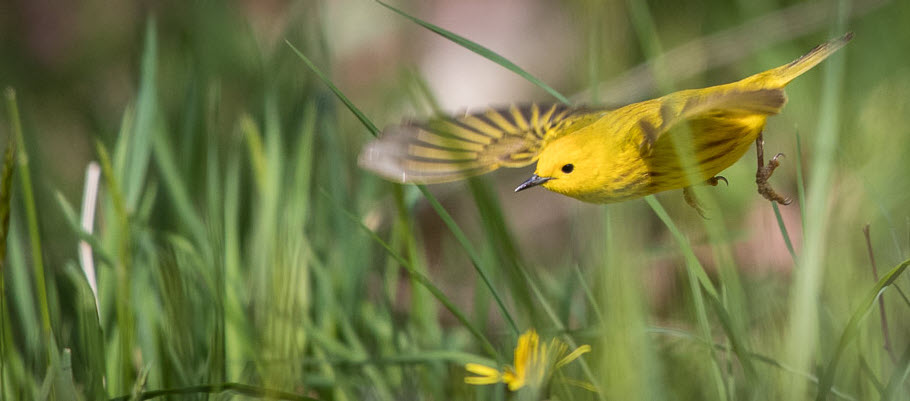David M. Larson

ERIC SWANZEY
Many species of animals have vocal alarm calls that they use to alert conspecifics to predators. This intraspecific communication is particularly widespread in songbirds and involves different vocalizations for different types of threats. As noted in an earlier "Gleanings," Black-capped Chickadees have different alarm vocalizations for flying and perched raptors (Larson 2016). Specific alarm calls for other dangers, such as nest parasites, are less commonly recognized.
Effective nest defense against brood parasites is enhanced by early detection and deterrence. Yellow Warblers (Setophaga petechia) have developed a distinct seet call that signals the presence of Brown-headed Cowbirds (Molothrus ater). This referential alarm call, given by males and females, alerts their mates to the threat of brood parasitism from a cowbird. The elicited behavior in the female is not to join in mobbing the threat, but to return to and sit tight on the nest, blocking access by cowbirds. This cowbird-specific call contrasts with the Yellow Warbler's chip call, which is a generalized alarm call.
Eavesdropping by heterospecifics on alarm calls of various bird and mammal species has been widely reported. It even works on birders; when Red-winged Blackbirds (Agelaius phoeniceus) make that loud, high teew call, I look up for a flying raptor. Attention to alarm calls from other species is obviously adaptive. The specificity of that adaptation is the subject of a paper by Lawson, et al., 2020. This publication describes two types of experiments designed to determine if Red-winged Blackbirds eavesdrop on and respond to the cowbird-specific seet alarm calls of Yellow Warblers. Both experiments involved playback of alarm call recordings on nesting territories of these birds.
Experiments on Yellow Warbler territories took advantage of the proximity of the warbler and blackbird nesting territories. Playback of the warbler seet calls brought blackbirds into the warbler territory significantly more frequently than the warbler's chip alarm calls or the nonthreatening song of a Wood Thrush (Hylocichla mustelina) used as a control. In these experiments, the seet calls were as effective as cowbird chatter vocalizations, suggesting a functional equivalent of the two on eliciting aggressive behavior by blackbirds.
The second series of experiments involved playback near blackbird nests. In contrast to Yellow Warblers, Red-winged Blackbirds respond to cowbirds with a "front-loaded nest defense," using verbal and physical aggression. The purpose of these experiments was to test the hypothesis that territorial blackbirds would respond to nearby warbler seet calls using their aggressive nest-defense behavior. It turned out that male blackbirds were similarly likely to respond immediately to cowbird chatters, warbler seet calls, Blue Jay (Cyanocitta cristata)— a nest predator of warblers and blackbirds—calls, and blackbird alarm chatter, all as compared to the Wood Thrush song control. Males responded more quickly than females, but the latency patterns were similar. Males approached significantly closer to the speaker, suggesting a higher level of aggression, when it was broadcasting blackbird chatter than the other tested vocalizations. They also moved closer in response to cowbird chatter than to seets, jay calls, or thrush songs. Red-winged Blackbirds, male and female, called at a significantly higher rate in response to each of the stimuli, compared to the thrush control. These experiments clearly indicate that the blackbirds recognize the seet calls as evidence of a threat and respond with a generic aggressive response.
Male blackbird vocal responses to seet and cowbird chatter playback was negatively correlated with distance of the blackbird nest from a warbler territory, suggesting that blackbirds nesting more closely to warbler territories are more attentive and sensitive to these calls. Interestingly, this greater response of blackbirds may help to explain the reported higher nesting success of Yellow Warblers in locations near blackbird nests.
The authors looked for a response from other wetland species to the seet calls of Yellow Warblers, but more species responded to the chip calls, and there was little interest in the seet calls. This result suggests that the heterospecific response to the seet call may be limited to Red-winged Blackbirds.
The authors concluded that the blackbirds actively eavesdrop on their neighboring warblers and respond to the warbler's referential alarm seet calls by mounting a generalized predator defense. It seems that the Red-winged Blackbirds do not have a referential cowbird alarm system of their own, so they make use of the warbler's. Since the blackbird response to the seet calls provides some additional protection, presumably, to the warblers, this heterospecific alarm system could form a mutualistic communication system.
This research was carried out in several wetlands in three counties in central Illinois. It would be very interesting to see if a similar heterospecific alarm and response structure exists in other geographic areas within the joint range of these species.
David M. Larson, PhD, is the Science and Education Coordinator at Mass Audubon's Joppa Flats Education Center in Newburyport, the Director of Mass Audubon's Birder's Certificate Program and the Certificate Program in Bird Ecology (a course for naturalist guides in Belize), a domestic and international tour leader, President of the Nuttall Ornithological Club, and a member of the editorial staff of Bird Observer.
References
- Larson, D.M. 2016. Gleanings: Did you hear that? Bird Observer 44(1):43-5.
- Lawson, S.L., J.K. Enos, N.C. Mendes, S.A. Gill, and M.E. Hauber. 2020. Heterospecific eavesdropping on an anti-parasitic referential alarm call. Nature Communications Biology 3:143 doi.org.10.1038/s42003-020-0875-7.